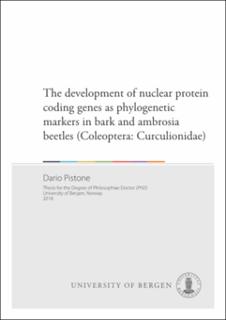| dc.description.abstract | Bark and ambrosia beetles are grouped into two different subfamilies (Scolytinae and Platypodinae), within the superfamily Curculionoidea (more than 60,000 described species). These insects constitute a large part (circa 8,000 species) of the advanced weevils (family Curculionidae). The subfamilies Scolytinae and Platypodinae were traditionally considered closely related, due to anatomical affinities and similar ecological behavior of their members. Indeed, these beetles present morphological modifications which allow them to spend almost all the entire lifecycle in tunnels constructed mainly in dead wood, though showing extraordinary variation in ecological adaptations to thrive in different niches. Despite the large interest focused on Scolytinae and Platypodinae which include economically important pests, the evolutionary history of these two groups is largely unclear (especially for Scolytinae) as well as their precise placement in the weevil tree. Due to the high number of species and the lack of molecular markers, obtaining high phylogenetic resolution for framing the timing and ecological circumstances under which each of the largest radiations originated still represent a great challenge. Even though this is one of the beetle taxa where more efforts were concentrated in collecting molecular data, the low phylogenetic resolution at deeper nodes has not been markedly improved adding only a few protein coding genes. Morphological characters in larvae, pupae and adults together with few mitochondrial and nuclear molecular markers clarified only a limited number of important evolutionary issues in Scolytinae, while Platypodinae phylogeny is significantly more resolved. This PhD research project focused on the development and standardization of nuclear protein coding genes as phylogenetic markers for weevils. One hundred genes were tentatively PCR amplified and sequenced with ‘classic’ Sanger technology for different species of Scolytinae, Platypodinae and other weevils. After this preliminary screening, unsuitable genes were discarded and the most promising ones were further tested in their capacity to recover monophyly for well-supported tribes. A total of sixteen protein coding genes emerged as first choice markers for reconstructing the phylogeny of Scolytinae, a subset of them were tested in other members of Curculionoidea and additional eighteen markers were shown to present different degree of utility for shallow level phylogenetics in weevils (e.g. tribes, genera and at population level). In the first section of this study (paper I), the procedure of development and optimization of each selected marker was described. Information on the intron length and number were reported for all the sixteen nuclear genes. Problems of unspecific amplification or primer failure in particular taxa were also emphasized. Finally, the novel genes were tested under different methods of phylogeny reconstruction (NJ, maximum parsimony and Bayesian inference), for their ability to recover well-established relationships among closely related species. The integrative knowledge provided by comparison among the different analyses allowed ranking the selected markers according to their utility for higher level phylogenetics in Scolytinae. In the second section of this work, a total of 18 markers (five previously defined and 13 out of the 16 developed in this study) were used to reconstruct the phylogeny of the subfamily Scolytinae applying two different phylogenetic methods: maximum parsimony and Bayesian inference. Among the major findings, the tribe Scolytini and the genus Microborus were confirmed to be early divergent lineages. However, their placement at the base of the Scolytinae tree or close to other subfamilies in the weevil tree remains to be clarified. The tribe Hypoborini was recovered as the sister lineage to a group containing the species-rich Dryocoetini and Ipini. Better resolution was achieved within different tribes and the placement of a few enigmatic species was unambiguously solved, but the relationships among older tribes remained elusive (paper II). Finally, ten genes (five developed in this study) were used to reconstruct the phylogeny of different weevil families and subfamilies (paper III). All the analyses placed the subfamily Platypodinae as the sister lineage to Dryophthorinae with high node support, therefore more distantly related to Scolytinae. | en_US |
